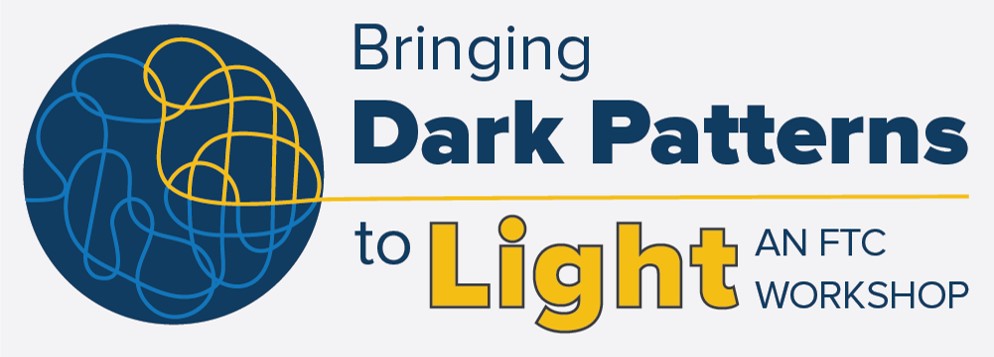Have you marked your calendar for April 29, 2021, to attend Bringing Dark Patterns to Light: An FTC Workshop? The virtual event will examine digital “dark patterns,” potentially deceptive or unfair user interfaces on websites and mobile apps. In addition to your participation, the FTC is asking for research and public comments on topics related to the workshop.
 Consumers who have found unwanted items in their online shopping carts or who have had to navigate a maze of confusing screens and questions to avoid unauthorized charges for products or services have experienced the injurious impact of dark patterns. You’ll want to check the event page for a full list of the issues about which the FTC is seeking public comment, but here is a summary:
Consumers who have found unwanted items in their online shopping carts or who have had to navigate a maze of confusing screens and questions to avoid unauthorized charges for products or services have experienced the injurious impact of dark patterns. You’ll want to check the event page for a full list of the issues about which the FTC is seeking public comment, but here is a summary:
- Defining Dark Patterns. What is a dark pattern? How do dark patterns differ from other types of persuasive technology and techniques (e.g., features known as “nudges”)? How do dark patterns differ from analogous advertising and sales tactics in the brick-and-mortar context?
- Prevalence of Dark Patterns. How prevalent are dark patterns in the marketplace? Are there particular industries or platforms where dark patterns are especially prevalent?
- Factors Affecting the Adoption of Dark Patterns. What factors influence the decision to employ dark patterns? What role has user experience testing played? How has “growth hacking” contributed to dark patterns?
- Dark Patterns and Machine Learning. How are machine learning and artificial intelligence affecting dark patterns? Is there empirical evidence of companies using AI or machine learning to serve dark patterns to individual consumers or specific groups of consumers?
- Effectiveness of Dark Patterns. How effective are dark patterns at influencing consumer choice or behavior? Are some dark patterns more effective than others?
- Harms of Dark Patterns. What harms do dark patterns pose to consumers or competition? Are any groups more likely to be affected – for example, kids, teens, older adults, or persons with low income? Do dark patterns have a disproportionate impact on consumers of color or other historically disadvantaged groups? Do dark patterns have any pro-consumer or pro-competition benefits?
- Consumer Perception of Dark Patterns. How able are consumers to detect dark patterns? Even when consumers detect a dark pattern, are they likely to understand how it’s influencing their behavior? Do any disclosures help consumers detect and avoid them?
- Market Constraints and Self-Regulation. Do market forces – for example, competition or reputational concerns – sufficiently prevent companies from using harmful dark patterns? What self-regulatory measures are companies and other stakeholders taking to mitigate the harm? Are there industry standards regarding the use of dark patterns?
- Priorities and Solutions. What would effective prevention and mitigation of the harmful effects of dark patterns look like? What role can industry play? How should the FTC and other government agencies continue to identify and combat deceptive, unfair, or otherwise unlawful dark patterns? What types of dark patterns should the FTC and other agencies focus on when bringing enforcement actions?
We’re particularly interested in data, research, and other empirical evidence addressing these issues. You can file your public comment online by May 29, 2021. That gives you extra time after the workshop to offer your insights.
Minutes before Bringing Dark Patterns to Light convenes at 10:30 AM Eastern Time on April 29th, we’ll post a link so you can watch the webcast live.

It is your choice whether to submit a comment. If you do, you must create a user name, or we will not post your comment. The Federal Trade Commission Act authorizes this information collection for purposes of managing online comments. Comments and user names are part of the Federal Trade Commission’s (FTC) public records system, and user names also are part of the FTC’s computer user records system. We may routinely use these records as described in the FTC’s Privacy Act system notices. For more information on how the FTC handles information that we collect, please read our privacy policy.
The purpose of this blog and its comments section is to inform readers about Federal Trade Commission activity, and share information to help them avoid, report, and recover from fraud, scams, and bad business practices. Your thoughts, ideas, and concerns are welcome, and we encourage comments. But keep in mind, this is a moderated blog. We review all comments before they are posted, and we won’t post comments that don’t comply with our commenting policy. We expect commenters to treat each other and the blog writers with respect.
We don't edit comments to remove objectionable content, so please ensure that your comment contains none of the above. The comments posted on this blog become part of the public domain. To protect your privacy and the privacy of other people, please do not include personal information. Opinions in comments that appear in this blog belong to the individuals who expressed them. They do not belong to or represent views of the Federal Trade Commission.